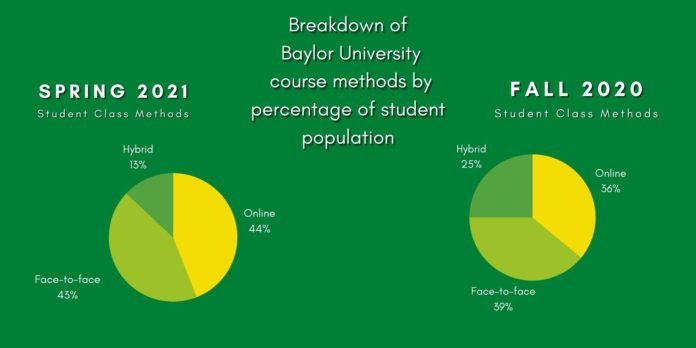By Erianne Lewis | Intern
As the spring semester commences, many students find themselves in a mix of fully online, in-person and hybrid classes determined ahead of time by Baylor through a strategic system to best benefit the students throughout the COVID-19 pandemic.
Dr. Wesley Null, vice provost for undergraduate education, wrote in an email that the provost’s office provided general information to schools on what type of courses they envisioned for this upcoming semester.
“We provided general guidance to schools and colleges regarding the modality breakdown we wanted to see (a minimum of 35% face-to-face and no more than 40-45% online), but, beyond that, departments had to take into account lots of factors when making decisions about individual courses (e.g., the number of students in the class, faculty members available, level of the class, type of class, general class vs. class for majors, number of sections to be offered, etc.),” Null wrote in an email.
In the fall, the provost’s office’s requirement for students to apply for online-only courses helped them create a schedule that fulfilled the demands students had for course types for this semester.
“We are quite pleased with how the process has gone with regard to spring planning, registration and course availability,” Null wrote in an email.
This spring, Baylor decided to reduce the number of hybrid courses because it felt they were more difficult for the faculty to teach.
“Our modality breakdown by section is approximately 43% face-to-face, 44% online, and 13% hybrid. Last fall, those percentages were 39% face-to-face, 36% online, and 25% hybrid,” Null wrote in an email.
Grapevine junior Lauren Hodge said that she had a difficult time choosing classes for this semester.
“Choosing my class schedule was rough because a lot of classes only offered online and if they did offer some in-person they were full,” Hodge said. “I wish, especially with being tested every week, that we had more in-person classes.”
Some students stayed away from taking many in-person classes this semester, while others felt that it was necessary for their learning.
Minneapolis freshman Janelle Ogechi said she was drawn to more in-person classes because she felt she was able to learn better that way.
“There were some classes that I was like, ‘I have to pick a balance between online and in-person because online is a lot harder for me to balance’,” Ogechi said. “I think [I prefer mostly] in-person because I just like being able to talk to my teacher, and it’s a lot easier of a setup.”
Amid the pandemic, having in-person classes provides some normalcy, Ogechi said.
“I wish it weren’t this way because I don’t get to communicate with classmates as well,” Ogechi said. “You do not really get to meet as many people, but the way they have it set up is pretty safe. It gives a little bit of the college experience without being too dangerous.”
Many freshmen students said they found navigating the course selection for the spring semester challenging at first and were worried about getting the classes they wanted due to the changes made regarding course types.
Naperville, Ill., freshman Naomi Thevatheril said she was worried about BearWeb crashing but is thankful that it did not happen and that the process was easier than expected.
“As long as you prepared what classes you wanted beforehand then everything went really smoothly,” Thevatheril said.
Regarding having mostly in-person classes, Thevatheril said that she felt her professors were serious about adhering to Baylor’s COVID-19 procedure.
“It’s really comforting to know that all the professors are taking the pandemic seriously and doing whatever they can to make sure that we feel safe and comfortable in the class, while also providing the best possible learning experience,” Thevatheril said.






